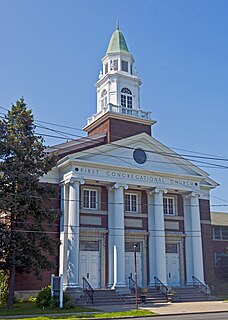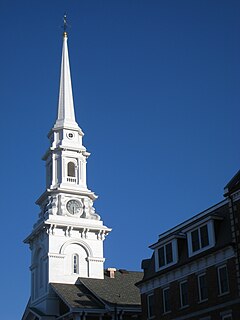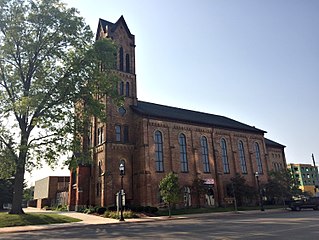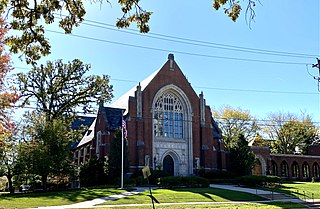
Congregational churches are Protestant churches in the Calvinist tradition practising congregationalist church governance, in which each congregation independently and autonomously runs its own affairs.
The Congregational Christian Churches were a Protestant Christian denomination that operated in the U.S. from 1931 through 1957. On the latter date, most of its churches joined the Evangelical and Reformed Church in a merger to become the United Church of Christ. Others created the National Association of Congregational Christian Churches or joined the Conservative Congregational Christian Conference that formed earlier in 1945. During the forementioned period, its churches were organized nationally into a General Council, with parallel state conferences, sectional associations, and missionary instrumentalities. Congregations, however, retained their local autonomy and these groups were legally separate from the congregations.

The Peoples Church of East Lansing is an interdenominational Protestant congregation located in the city of East Lansing, Michigan. It is officially a member of the American Baptist Churches USA, the Presbyterian Church (U.S.A.), the United Church of Christ, and the United Methodist Church. The congregation's membership currently numbers around 1,300.

The Beneficent Congregational Church is a United Church of Christ Congregationalist church located at 300 Weybosset Street in downtown Providence, Rhode Island. The congregation was founded in 1743 during the "First Great Awakening" as a separatist spin-off from a Congregationalist group on the east side of the Providence River, and built their first sanctuary on this site. The current church was built in 1809 and was extensively remodeled in the Greek Revival style in 1836.
Sidney Rose Badgley was a prominent start-of-the-20th-century Canadian-born architect. He was active throughout the United States and Canada, with a significant body of work in Cleveland.
Plymouth Church of Shaker Heights is a church located in Shaker Heights, Ohio, USA. It is a member of the United Church of Christ. The Senior Minister is Rev. Dr. Matthew Wooster. The church building, dedicated in 1923, has been designated a landmark by the Shaker Heights Landmarks Commission.

The Circular Congregational Church is a historic church building at 150 Meeting Street in Charleston, South Carolina, used by a congregation established in 1681. Its parish house, the Parish House of the Circular Congregational Church, is a highly significant Greek Revival architectural work by Robert Mills and is recognized as a U.S. National Historic Landmark.

The First Presbyterian Church in Batavia, New York, United States, is located at East Main and Liberty streets. It is a joined complex of several buildings. The main one, the church's sanctuary, is a limestone Gothic Revival structure built in the mid-19th century. Its congregation was the first church to be organized in Batavia, albeit as a Congregationalist group at that time.

The Whitneyville Congregational Church, now the Whitneyville United Church of Christ, is a historic Congregational Church at 1247-1253 Whitney Avenue in the Whitneyville section of Hamden, Connecticut. The congregation is now affiliated with the United Church of Christ (UCC). The church building is a Greek Revival style built in 1834, with an interior altered in 1866 to designs by Rufus G. Russell. The church, along with its 1924 parish house, was added to the National Register of Historic Places in 1995 for its architecture.

The Grafton Congregational Church, known locally as The Brick Church, is a historic church on Main Street in Grafton, Vermont. Built in 1833, it is a fine local example of vernacular Greek Revival and Gothic Revival religious architecture. It was listed on the National Register of Historic Places in 1979. Grafton's current Congregationalist congregation now meets primarily in the "White Church" at 55 Main Street.

The United Church of Ludlow, formerly the Congregational Church of Ludlow, is a historic church at 48 Pleasant Street in the village of Ludlow in Vermont. Built in 1891, it is one of the only churches in the state built in a fully mature expression of Shingle Style architecture. Its Congregationalist congregation was organized in 1806, and in 1930 it merged with a Methodist congregation to form a union congregation. The church was listed on the National Register of Historic Places in 2004.

The Fourth Presbyterian Church of Chicago is one of the largest congregations of the Presbyterian Church (U.S.A.), located in the Magnificent Mile neighborhood of Chicago, directly across Michigan Avenue from the John Hancock Center.

Congregational United Church of Christ is located in the downtown area of Iowa City, Iowa, United States near the campus of the University of Iowa. The congregation was organized in 1856 and the church building was listed on the National Register of Historic Places in 1973. In 2004 it was included as a contributing property in the Jefferson Street Historic District.

Brooklyn Tabernacle is an evangelical non-denominational megachurch located at 17 Smith Street at the Fulton Mall in downtown Brooklyn, New York City. The senior pastor is Jim Cymbala.

The 27th Street Historic District is a historic district in the South Los Angeles area of Los Angeles, California. The district was listed on the National Register of Historic Places in 2009 as part of the multiple property submission for African Americans in Los Angeles.

The First Congregational Church of Albany, also known as The Ray Palmer Memorial, is located on Quail Street in the Woodlawn section of Albany, New York, United States. It is a brick building in the Colonial Revival architectural style built in the 1910s and expanded half a century later. In 2014 it was listed on the National Register of Historic Places.

Congregationalism in the United States consists of Protestant churches in the Reformed tradition that have a congregational form of church government and trace their origins mainly to Puritan settlers of colonial New England. Congregational churches in other parts of the world are often related to these in the United States due to American missionary activities.

The First Congregational Church is a historic church in downtown Jackson, Michigan, adjacent to the original city square. It was listed as a Michigan State Historic Site in 1987 and added to the National Register of Historic Places in July 2017. The church is currently home to the First Congregational Church, United Church of Christ of Jackson.

The Congregational Church of Plainville is a historic church building at 130 West Main Street in Plainville, Connecticut. Built in 1850, it is one Connecticut architect Henry Austin's significant church designs, exhibiting a mix of Carpenter Gothic and Romanesque features. It was built for a congregation formally organized in 1839 that is now affiliated with the United Church of Christ. The church was listed on the National Register of Historic Places in 2012.

Plymouth Church is an historic congregation located in Des Moines, Iowa and is a member of the United Church of Christ. Plymouth is known for its long history of social justice work including anti-racism and suffrage advocacy, ClimateCare, and aid to unhoused and refugee populations. Plymouth Church is an Open and Affirming church, a Stephen Ministries church, and a Just Peace Church. The church building, located at 42nd and Ingersoll Avenue, is included as a contributing property in the Greenwood Park Plats Historic District and listed on the National Register of Historic Places in 2013. The official name of the church is Plymouth Congregational Church of the United Church of Christ.






















